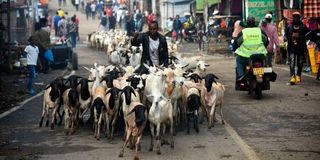
Nairobians living in crowded areas risk contracting emerging diseases that jump from animals to humans, according to a new study.
| FileCrowded Nairobi: How diseases could jump from livestock to humans
Nairobians living in crowded areas risk contracting emerging diseases that jump from animals to humans, according to a new study.
The study, published yesterday in the Proceedings of the National Academy of Sciences (PNAS) — a US a peer-reviewed multidisciplinary scientific journal — shows that city dwellers who live with livestock, some birds, bats and urban-adapted rats need consistent disease surveillance that will help strengthen their health care and inform scientists about some of the control measures that will stop the spread of diseases.
The study shows that people living in areas with poor sanitation, waste management and less biodiversity are likely to be most negatively affected by the spillover of zoonotic diseases - those that jump from animals to humans.
According to a statement from the International Livestock Research Institute (ILRI), the study is among the first to provide solid evidence to support scientific hypotheses about where and how disease transmission occurs in urban areas.
The study's lead researcher, Dr James Hassell, a wildlife veterinarian and epidemiologist with the Smithsonian's National Zoo and Conservation Biology Institute's (NZCBI) Global Health Program, worked with researchers from Kenya and the UK.
The data was collected in 2016 in collaboration with a UK-based project called Urban Zoo, and the samples were then analysed in laboratories at the Kenya Medical Research Institute (Kemri) and the University of Nairobi.
The analysis looked at the genetic relationships of E. coli bacteria collected from more than 2,000 people, livestock and urban wildlife from 33 locations in Nairobi.

Cows feed on a pile of garbage along Jogoo Road, Nairobi on November 14, 2021.
"E. coli bacteria have some genes, called mobile genetic elements, that carry traits such as drug resistance and can be transferred to other E. coli nearby. This allowed Hassell and his colleagues to infer the same kind of close physical proximity between any E. coli that shared many of the same mobile genetic elements," said an ILRI statement.
According to the Centres for Disease Control and Prevention, E. coli can cause infections such as pneumonia, urinary tract infections and bloodstream infections.
"Some strains of E. coli have become very resistant to several, if not all, antibiotics and are known as multidrug-resistant," the CDC explains.
Dr Hassell says that genetic similarity is a good proxy for the potential for disease transmission between two hosts.
"We can't know if the bacteria were passed from human to animal or animal to human, but it tells us something important about the epidemiological link between them," he explains.
Dr Hassell and his team used the data collected in Nairobi to map the areas of the city most affected by these bacterial genes, in order to devise control measures.
"The idea is that if the bacteria from a person and a cow, for example, get close enough to develop significant genetic overlap, then their hosts could get close enough to exchange viruses," the study explains.
The scientists say their findings are a replica of what could happen in most cities in tropical regions, where an influx of new residents is coupled with unplanned urbanisation.
"When cities grow extremely fast without meaningful urban planning, they often lack basic infrastructure such as adequate sanitation or waste management systems, especially in low-income neighbourhoods," they said.

A man drives goats to graze in Huruma, Nairobi on May 8, 2021
"Combine these conditions with high population densities and large numbers of residents still relying on livestock to support their families, and the opportunities for diseases to jump from animals to humans are abundant," they added.
People living in informal settlements have less biodiversity, but those that do exist, such as rats and bats, are likely to be disease vectors.
The final analysis showed that neighbourhoods with the highest densities of people and livestock, and the lowest levels of biodiversity, had the greatest degree of genetic overlap between E. coli samples collected from humans and animals.
The scientists concluded that poor management of livestock manure, especially within households, in these communities was an important source of genetic overlap between wildlife and livestock.
"These are the places where the ingredients are there for emerging pathogens to jump from animals to humans, and where it would be easy for those pathogens to multiply before being detected," said Dr Hassell.
The researchers advised that improving sanitation and waste management, particularly the handling of livestock manure, is an ideal intervention.
"We can't really redesign urban environments to completely eliminate the risk of disease spillover. But what we want to do is detect these diseases quickly and minimise their impact. To do that, the focus needs to be on access to quality healthcare that can diagnose and identify new pathogens,” recommended Dr Hassell.
The scientists are advancing their study by trying to find out how the diseases are transmitted, and have since fitted some of the surveyed households' livestock, bats and birds with tracking devices.
The study is using GPS tracking as well as devices called proximity loggers, which record when two animals wearing the devices come within half a metre of one another to create contact networks.





